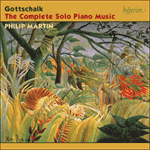Here is Gottschalk’s Opus One composed when he was about fourteen years old, and interesting if only as a well-crafted piece of juvenilia. The score, ‘composée pour le piano par Moreau Gottschalk’, bears a dedication to a Madame Céline Courtois. It is a charming, if slight, example of its kind which he later rewrote as
Danse ossianique, Op 12 (1850–51) RO64 (Paris, 1851). (For comments on Gottschalk and the poet ‘Ossian’, see CD 4 and the note on the two Ossian ballades.) S Frederick Starr observes of the final version of this piece ‘if the bass line were changed to a habanera rhythm or if it were syncopated, the piece as a whole would be transformed into a jaunty Caribbean dance.’
from notes by Jeremy Nicholas © 2001
Voici L’Opus Un de Gottschalk, composé lorsqu’il avait quatorze ans, intéressant ne serait-ce que par l’âge du compositeur et l’écriture fort bien tournée. La pièce «composée pour le piano par Moreau Gottschalk» porte une dédicace à Madame Céline Courtois. Il s’agit d’un exemple charmant, même s’il est un peu léger, qui fut plus tard réécrit et publié sous le titre
Danse ossianique, op. 12 (1850–51) RO64 (Paris, 1851). (Pour les commentaires sur Gottschalk et le poète «Ossian» consulter le CD 4 et la note sur les deux Ossian ballades). S Frederick Starr observe, sur la version finale de l’œuvre, que «si la basse prenait le rythme de la habanera ou était syncopée, la pièce se transformerait en une danse enjouée des Caraïbes».
extrait des notes rédigées par Jeremy Nicholas © 2001
Français: Marie Luccheta
Dies ist Gottschalks Opus Eins, im Alter von etwa vierzehn Jahren komponiert und vorwiegend als technisch gelungenes Jugendwerk von Intreresse. Die Partitur, „composée pour le piano par Moreau Gottschalk“, ist mit einer Widmung für eine Madame Céline Courtois versehen. Es ist in seiner Art ein charmantes, wenn auch leichtgewichtiges Stück, das er später zu seinem
Danse ossianique Op. 12 (1850/51) RO 64 (Paris 1851) umarbeitete. (Für einen Kommentar zu Gottschalk und dem Dichter „Ossian“ siehe CD 4 und dort die Anmerkung zu den beiden Ossian Ballades.) S. Frederick Starr meint zur letzten Fassung dieses Stücks: „Wenn die Baßlinie in einen Habanera-Rhythmus umgewandelt oder synkopiert würde, ließe sich das ganze Stück in einen beschwingten karibischen Tanz verwandeln.“
aus dem Begleittext von Jeremy Nicholas © 2001
Deutsch: Anne Steeb/Bernd Müller


 Gottschalk: The Complete Solo Piano Music
Gottschalk: The Complete Solo Piano Music
